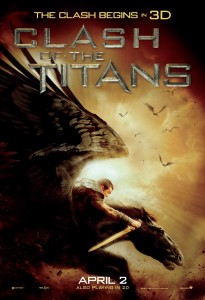Miriam Ross Research Provocation: Post-production conversions, the Ugly, the Bad and the Good
Unavailable in the analogue eras of 3D cinema (although arguably available in early 3D animation), post-production conversion came to the forefront of public perception when Alice in Wonderland and Clash of the Titans exhibited conversion technology in 2010. Although technological processes vary, the basic process is the digital fabrication of a corresponding other-eye image from an existing singular image. Both films were heavily critiqued for producing ‘fake 3D’ that was flat, planar and inadequate. The frequency with which Hollywood implemented conversion technology (in 2011 around 22 films were converted) brought critical fear that the studios would post-convert their back catalogues in a similar way to the attempted conversion of black and white films to colour in the 1980s. Even though some conversions of previously released 2D films – Titanic (1997/2012) and Jurassic Park (1993/2013) for example – were lauded for the new ‘dimensions’ they added to cinematic classics, the critics’ consensus was that post-production conversion represented a cheap add on in order to help Hollywood lure audiences to the movie-theatre.
Within the criticism of conversion processes, old hierarchies of quality returned (particularly those privileging Hollywood as the true centre for production). Celebrating Resident Evil Retribution’s (2012) use of 3D during production, director of photography Glen MacPherson stated that ‘if you post-convert, you don’t even think about that. And then you hand it off to a bunch of kids in Bulgaria doing the conversion for you, and you’ve lost all control‘ (2012). Various filmmakers and studio executives have tried to negotiate the stigma associated with conversion and a common approach has been to emphasise the lengthy time and dedication given to their conversion processes as well as their application of advanced new technology that supersedes previous primitive conversion techniques. James Cameron’s Titanic offers a particularly good example as many of the press releases around its conversion to 3D focused on the more than 60 weeks duration of the work and the $18 million allocated to completing the conversion (Mekado, Jean and Myint, 2012).
Nonetheless, critiques have continued with an emphasis on the difference between what is now termed native 3D and conversion 3D. Frequently this distinction is conflated with a distinction between real and fake. Websites such as realorfake3d.com make this clear and on 31 March 2012 The Electric Cinema Birmingham (UK) movie-theatre tweeted that it would not show Iron Man 3 (2013) or Star Trek Into Darkness (2013) in 3D as they were post-production conversions (it does show 3D features that have been shot with 3D processes). Within The Electric Cinema’s decision was the perception that audience members can somehow tell or distinguish real from fake and that screening the latter will somehow cheat them of the cinematic experience they believe they are paying for.
On the one hand, this valorisation of content shot in 3D effaces the continuing appearance of stereoscopic errors in native production. A recent series of reports by the Graphics and Media Lab at Moscow State University (Voronov, et al. 2013) has highlighted a number of recurring errors producing visual discomfort in 3D films such as horizontal and vertical disparity, colour mismatch and sharpness mismatch. Often post-production conversions are able to control similarity (particularly colour and alignment) between images more effectively than native productions. While post-production conversions may not be able to replicate the depth relations of objects as effectively as ‘native’ productions, a nuanced approach can evaluate both the benefits and problems of the two different ways of producing 3D content.
On the other hand, the valorisation of ‘true’ 3D effaces the growing trend towards hybrid productions. Both Transformers Dark of the Moon (2011) and Pacific Rim (2013) included a mixture of shots that were filmed using 3D processes and shots that were converted. Often the various composite layers in each shot means that an individual shot included both native and converted 3D elements. In each film it is almost impossible to tell not only which shots have been converted but which components within a shot have been converted. These films also point to a common tendency in all digital 3D films: although many films may shoot in 3D, the use of post-production technology to digitally ‘touch-up’ shots makes it difficult to describe where the ‘real’ of the 3D imagery lies.
In our contemporary context, discussions in favour of ‘real’ 3D attempt to return to older understandings of cinema technology that rely on the indexical relationship with the real that analogue capture once seemed to offer. There is a sense of nostalgia for technologies that are able to directly transfer real-world visual information into a cinematic representation. This tendency suggests a suspicion of virtual environments at the same time that the majority of 3D films are produced in a Hollywood blockbuster context that is obsessed with computer generated imagery. While seemingly contradictory it may be more than a coincidence that these conversations emerge at the same time that certain directors, Christopher Nolan, for example, are praised for returning to in-camera (rather than digital) special effects. As new technology develops and blurs the difference between native and converted 3D it is unlikely that debates around their merits will disappear but it may be possible to produce more complex evaluations of what these different technological approaches offer.
References
Murphy, Mekado, Paul Jean and Jacky Myint (2012) ‘Inside the 3-D Conversion of ‘Titanic’’ in The New York Times, March 30 http://www.nytimes.com/interactive/2012/03/29/movies/titanic-3d-conversion.html?_r=1&
Sweeney, R. Emmet (2012) ‘Interview: Glen MacPherson 3D DP’ in Film Comment.com http://filmcomment.com/entry/interview-glenn-macpherson-3d-dp-resident-evil
Voronov, A, D. Vatolin, D. Sumin, V. Na- padovsky and A. Borisov (2013) ‘Methodology of Stereoscopic Motion Picture Quality Assessment,’ in Stereoscopic Displays and Applications XXIV, Proc. of SPIE-IS&T Electronic Imaging, SPIE Vol. 8648 http://compression.ru/video/vqmt3d/


